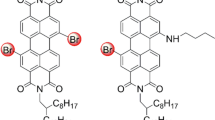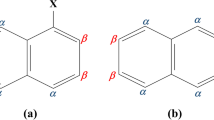Abstract
The singlet-triplet splitting energy gap ΔES-T=ES-ET is calculated for the ortho-, meta-, and para-xylylenes and their heteroatomic analogous by means of AM1-CI approach. It is shown that when the radical centers\(R^. (R^. = H_2 C^. - ,H_2 N^{. + } - or HN^. - )\) are twisted sufficiently far out of conjugation with the benzene ring, ΔES-T tends to zero or is negative, i.e. ortho-, meta-, and para-phenylenes turn into weak ferromagnetic or antiferromagnetic coupling unit, while they are strong ferromagnetic (meta-isomers) or antiferromagnetic (ortho-, para-isomers) coupling units under planar conformation. It is suggested that serious twisted conformation is not recommended candidate for the design of novel high-spin molecules with stable high-spin ground states by ortho- or para-phenylene coupling unit.
Similar content being viewed by others
References
Miller, J. S., Epstein, A. J., Ferromagnetic molecular charge-transfer complexes, Chem. Rev., 1988, 88: 201.
Miller, J. S., Epstein. A. J., Organic and organometallic molecular magnetic materials-designer magnets, Angew. Chem. Int.Ed.Engl., 1994, 33: 385.
Iwamura, H., High-spin organic molecules and spin alignment in organic molecular assemblies, Adv. in Phys. Org. Chem., 1990, 26: 179.
Rajca, A., Organic diradicals and polyradicals: From spin coupling to magnetism? Chem. Rev., 1994, 94: 871.
Longuet-Higgins, H. C., Resonance structures and molecular orbitals in unsaturated hydrocarbons, J. Chem. Phys., 1950, 18: 265.
Ovchinnikov, A. A., Multiplicity of the ground state of large alternant organic molecules with conjugated bonds, Theor. Chim. Acta., 1978, 47: 297.
Borden, W. T., Davidson, E. R., Effects of electron repulsion in conjugated hydrocarbon diradicals, J. Am. Chem. Soc., 1977, 99: 4587.
Klein, D. J., Valence bond theory for conjugated hydrocarbons, Pure Appl. Chem., 1983, 55: 299.
Radhakrishnan, T. P., Soos, Z. G., Entires, H. et al., Structure and magnetism of NN♪N♪-tetramethyl-p-phenylenediamine - pentacyclopentadie-nide (TMPD-PCCp), J. Chem. Phys., 1986, 85: 1126.
McConnell, H. M., Ferromagnetism in solid free radicals, J. Chem. Phys., 1963, 39: 1910.
Fukutome, H., Takahashi, A., Ozaki, M. A., Design of conjugated polymers with polaronic ferromagnetism, Chem. Phys. Lett., 1987, 133: 34.
Dvolaitzky, M., Chiarelli, R., Rassat, A., Stable N, N’-Di-tert-butyl-meta-phenylene-bisnitroxides—unexpected ground- state singlets, Angew. Chem. Int. Ed. Engl., 1992, 31: 180.
Kanno, F., Inou, K., Koga, N. et al., 4,6-Dimethoxy-l, 3-phenylene bis(N-tert-butyl nitroxide) with a singlet ground state, Formal violation of a rule that m-phenylene serves as a robust ferromagnetic coupling unit, J. Am. Chem. Soc, 1993, 115: 847.
Ishida, T., Iwamura, H., Bis[3-tert-butyl-5-(N-oxy-tert-butylamino)phenyl]nitroxide in a quartet ground state: A prototype for persistent high-spin poly[(oxyimino)-l,3-phenylenes], J. Am. Chem. Soc., 1991, 113: 4238.
Okada, K., Imakuma, T., Oda, M. et al., 10, 10-(m- and p-phenylene) diph enothiazine dications: Violation of a topology rule in heterocyclic high-spin re-systems, J. Am. Chem. Soc., 1996, 118: 3047.
Fang, S., Lee, M.-S., Hrovat, D. A. et al.,Ab initio calculations show why m-phenylene is not always a ferromagnetic coupler, J. Am. Chem. Soc., 1995, 117: 6727.
Dewar, M. J. S., Zoebisch, E. G., Healy, E. F. et al., AMI: A new general purpose quantum mechanical molecular model, J. Am. Chem. Soc., 1985, 107: 3902.
Steward, J. J. P., Frank, J., Seiler Research Laboratory, United States Air Force Academy CO 80840, 1990.
Zhang, J., Karabunarlieve, S., Baumgarten, M., The ground state spin multiplicity of Schlenk-type biradicals and the influence of additional linkage to ladder type structures, Chem. Phys., 1996, 206: 339.
Zhang, J., Baumgarten, M., The stability of ground state multiplicities in triradicals and their dependence on configuration and confirmation, Chem. Phys. Lett., 1997, 269: 187
Zhang, J., Lahti, P. M., Wang, R. et al., Design of high-spin molecules incorporation charged plus neutral spin centers, Heteroatom Chem., 1998, 9: 161.
Zhang, J., Wang, R., Wang, L., The structural rule for the design of multiradicals with stable high spin ground states, Funct. Mater. Chinese, 1998, 29: 372.
Zhang, J., Lahti, P. M., Wang, R., Theoretical design of high spin organic molecules with two-center, three electron spin- containing units, J. Phys. Org. Chem., 1999, 12: 53.
Zhang, J., Wang, R., Wang, L. et al., Using triazine as coupling unit for intramolecular ferromagnetic coupling of multiradicals, Chem. Phys., 1999, 246: 209.
Zhang, J., Baumgarten, M., Using trazine as coupling unit for intra- and intermolecular ferromagnetic coupling I, Chem. Phys., 1997, 214: 291.
Zhang, J., Baumgarten, M., Novel supramolecular architecture of high-spin aggregates? Chem. Phys., 1997, 222: 1.
Zhang, J., Wang, R., Baumgarten, M., Role of hydrogen bonds in the propagation of ferromagnetic coupling between high spin molecules, Mol. Cryst. Liq. Cryst., 1997, 306: 119.
Zhang, J., Wang, R., Wang, L., The intermolecular coupling through space for stacked high spin molecules, Synth. Met., 1999, 103: 2273.
Heisenberg, W., Theory of ferromagnetism, Z. Phys., 1928, 49: 619.
Williams, D. J., Pearson, J. M., Levy, M., Nuclear magnetic resonance spectra of quinodimethanes, J. Am. Chem. Soc, 1970, 92: 1436.
Trahanovsky, W. S., Chou, C.-H., Fischer, D. R. et al., Observation of reactive o-quinodimethanes by flow NMR, J. Am. Chem. Soc., 1988, 110: 6579.
Author information
Authors and Affiliations
Corresponding author
Rights and permissions
About this article
Cite this article
Zhang, J., Zhang, H., Wang, L. et al. Effect of configuration and conformation on the spin multiplicity in xylylene type biradicals. Sc. China Ser. B-Chem. 43, 524–530 (2000). https://doi.org/10.1007/BF02969498
Received:
Issue Date:
DOI: https://doi.org/10.1007/BF02969498




